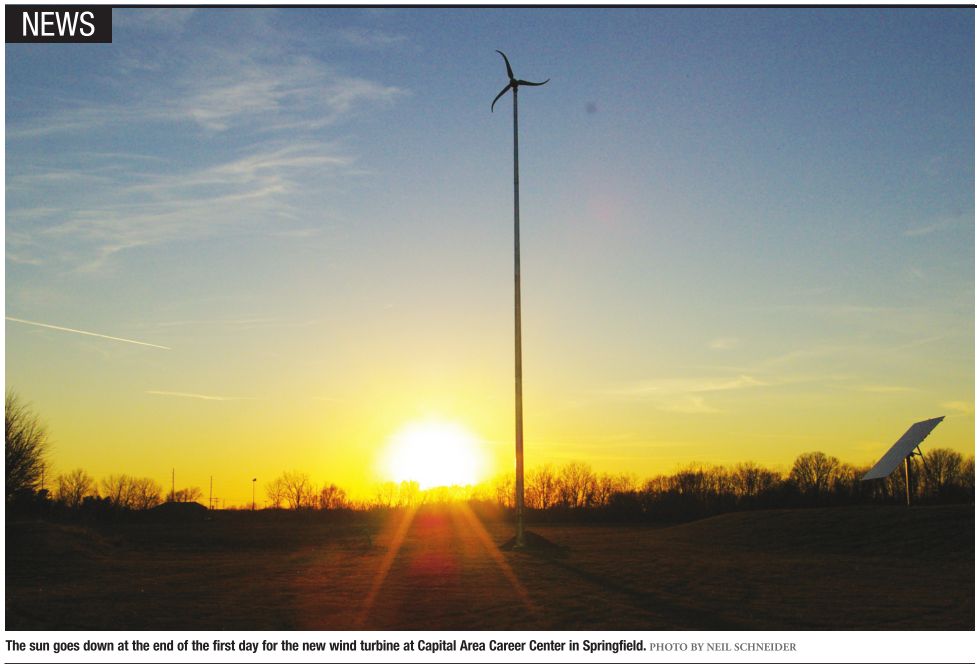
WIND | Neil Schneider
Students at the Capital Area Career Center now have a new opportunity to learn about wind technology, thanks to a new wind turbine erected on Friday, Jan. 6.
Jim Gain, CACC’s electrical/HVAC instructor, said that he became inspired to get the students of CACC involved in putting up a wind turbine after seeing them during his travels.
“I kept seeing all these wind turbines being put up while I was driving back and forth from Chicago to Springfield and I started thinking ‘You know, if we are going to be putting them up in the state, we should have people within the state who know how to work on them,’” Gain said.
Gain began the project, which started in October 2011, by gauging the interest of his colleagues and administrators at CACC about the alternative energy possibility, while also asking about funds and possible grant money that could be used for the wind turbine.
After receiving positive feedback from his peers, Gain applied for and received an alternative energy grant from the Regional Office of Career and Technical Education, located at 2450 Foundation Drive in Springfield.
The wind turbine, called the Skystream 3.7, is a 75-foot-tall vertical shaft with a wind-swept area (the area through which the rotor blades spin) of 21 feet. The wind turbine has a base on a five-foot-wide slab of concrete. The tower is hinged onto the base, making it easier to lower to the ground for access by the students to receive hands-on training with the mechanics of wind production.
The concrete was poured by the students of Gain’s class at CACC.
The wind turbine is able to provide up to 3,000 watts of electricity, depending on the amount of wind, to CACC through a direct grid system, which the students will be able to monitor through computers within the school.
Gain explained that his students and the students involved from other classes will be able to take away not only the fun aspects of the project, but also the thinking side.
“I like to teach my students that there is more involved than just the fun parts of a project,” Gain said.
“The students were involved with deciding which type of equipment was going to be used at each stage, where we would get that equipment and how to manage the money for the equipment. They really will take away some life skills from this type of a project – like time management, planning, researching and budgeting.”
Deb Antoine, CACC’s digital radio/TV instructor, said that in addition to her class taking pictures, documenting video and conducting interviews throughout the project, there are various other classes making contributions to the project.
“This project has been really great because it crosses the curriculum of many classes here at CACC,” Antoine said. “The agriculture and industrial mechanics program was instrumental in the initial trenching of the cables that run from the turbine into the grid.”
Antoine also said that the welding program helped with the project, while the CISCO networking program at CACC, a program that teaches students to design, build and secure computer networks, will assist in monitoring the wind turbine through CACC computers. The graphic arts program will also play a role by posting the project’s videos to the CACC website (http://www.capital.tec.il.us/).
Antoine estimated that up to 100 students will participate in this project.
Gain said that he was budgeting the project to not exceed $30,000 and he estimates the project will actually cost around $25,000. Paying for it was made possible with the help of various organizations throughout Illinois.
Gain said that the biggest point of the project was to provide the students with hands-on training in a field that he believes is going to continually expand.
“First, we have a need for it. Alternative energy is something that this country is going to need to rely on, especially if we are going to keep dealing with car emissions and the ever increasing prices of oil and natural gas generators,” Gain said.
Contact Neil Schneider at [email protected].
Visit illinoistimes.com for a video featuring the construction of the teaching windmill.